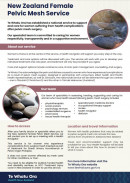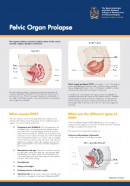- The term surgical mesh refers to a permanent synthetic implant that is usually made from a non-absorbable polypropylene (plastic) material.
- There are 2 types of surgical mesh – partially absorbable or non-absorbable. The most common mesh used is non-absorbable mesh. This remains in your body indefinitely so should be considered a permanent implant. If there are complications it may not be able to be removed.
- Surgical mesh is widely used for hernia repair and often in the treatment of stress urinary incontinence (SUI) and pelvic organ prolapse (POP), which includes bladder, uterine, vaginal, bowel and rectal prolapse.
- Most people who have mesh inserted, particularly for hernia repair, have no complications.
- Complications are rare and range from mild to very severe. However if they occur, they can have significant physical and psychological impacts and effects on your quality of life and mental wellbeing.
- To give informed consent, make sure you have had all the information, options and risks explained to you. This includes the possible benefits and risks of complications, as well as any alternative treatment options. Take time to consider your options and ensure you have enough information to make an informed decision.
- If you notice any unexpected symptoms or complications from surgical mesh, see a doctor straight away.
23 August 2023: Pause on the use of surgical mesh for stress urinary incontinence proceduresIn Aotearoa New Zealand a pause on the use of surgical mesh to treat stress urinary incontinence has been put in place by the Director-General of Health. The pause is for a limited time period while steps are put in place to ensure that any risk of harm associated with the procedure is as low as possible. If you are on the waiting list for stress urinary incontinence surgery using surgical mesh you will be contacted so that other ways to manage your condition can be discussed with you. The use of surgical mesh for other procedures will go ahead as usual. More information is available on the Ministry of Health's surgical mesh page.(external link) |








